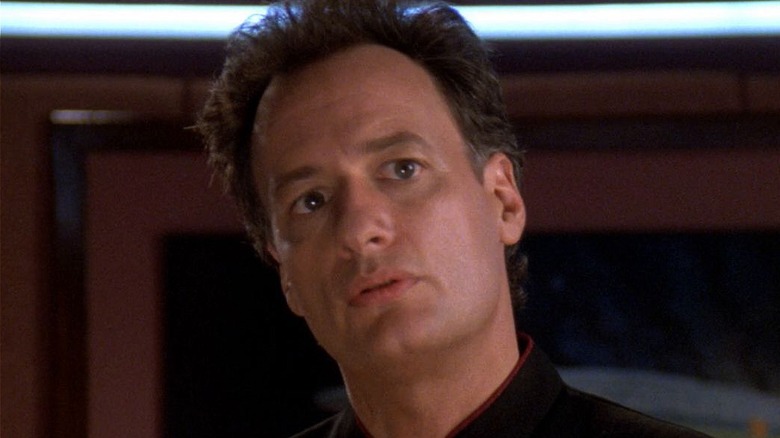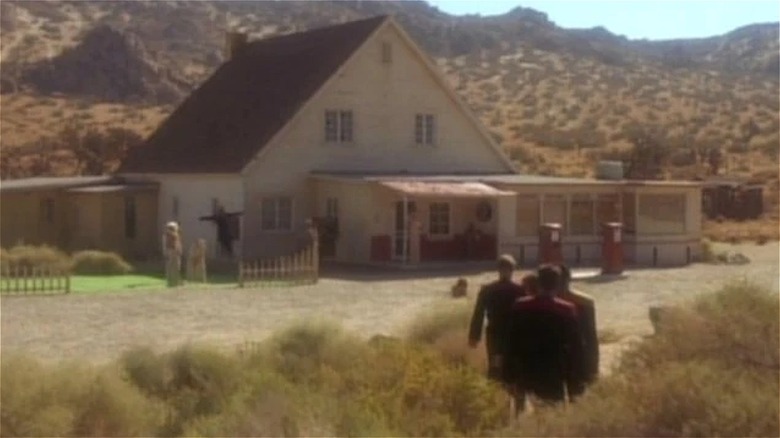Star Trek: What Is A Q?
From the good-natured ribbing of Archer (Scott Bakula) and Shran (Jeffrey Combs) to the relentless cat-and-mouse game of Odo (René Auberjonois) and Quark (Armin Shimerman), the "Star Trek" franchise loves a good frenemy relationship. And nobody does the complicated frenemy situationship better than Captain Jean-Luc Picard (Patrick Stewart) and Q (John de Lancie), the seemingly immortal and virtually omnipotent trickster who first singled the captain out in the "Star Trek: The Next Generation" series premiere, "Encounter at Farpoint." A fan favorite, John de Lancie's Q was almost the villain of the Star Trek movie "First Contact."
As a member of the Q race from the extradimensional Q Continuum, Q shares his name with every other being from his realm, collectively referred to as the Q species or Q Continuum. Although the veracity of his claims tends to be murky at best — the people of Brax call him "the god of lies" — Q insists that the Q race is eternal. This comes up on the "Star Trek: Voyager" episode "The Q and the Grey," when Q tells Captain Kathryn Janeway (Kate Mulgrew), "The Q didn't come into existence. The Q have always existed."
The Q possess vast powers, including the ability to manipulate energy and matter, alter perception, travel through time, and confer those powers to others. Despite their apparent omnipotence, a Q who adopted the name Quinn (Gerrit Graham) on the "Voyager" episode "Death Wish" once told Tuvok (Tim Russ), "You mustn't think of us as omnipotent, no matter what the Continuum would like you to believe. You and your ship seem incredibly powerful to lifeforms without your technical expertise." Quinn's comment supports the fan theory that Q powers are technology-based.
The Q are long-lived but can eventually die
The Q inhabit a plane of existence outside of the universe in which humanity resides. Although it exists in a way that is imperceptible to humans, Janeway and Tuvok are able to experience what Quinn calls a "manifestation" of the Q homeworld on "Death Wish," using symbolism to convey the monotony of eternal life in the Continuum. In Quinn's manifestation, the Q Continuum appears as a house along a long and lonesome desert road were other Q sit around in resigned disinterest. While the road is an "endless circle" that could take them anywhere, Quinn tells Janeway, "I traveled the road many times, sat on the porch, played the games, been the dog, everything. I was even the scarecrow for a while."
Lamenting the decline of Q civilization, former philosopher Quinn reveals that the Continuum once engaged in the pursuit of new discoveries and discourse. But with nothing new to experience or say and nothing but time to not experience or say it in, progress in the Continuum had come to a grinding halt. According to Quinn, many had not spoken in 10,000 years.
But despite their apparent longevity, it's revealed in the "Star Trek: Picard" episode "Farewell" that Q can die — something that seems to counter Q's earlier claim that one death would cause a disruption in the Continuum. Without revealing why or how, Q tells Picard, "In your parlance, I am dying," before using the last of his powers to send Picard and his friends home and restore the timeline. Nonetheless, as a being who exists outside of time, Q isn't gone for good. In a fourth wall-breaking scene in the "Star Trek: Picard" series finale, "The Last Generation," Q appears to Jack Crusher, teasing, "And here I was hoping the next generation wouldn't think so linearly."
To read more about the character, check out the untold truth of Q.

